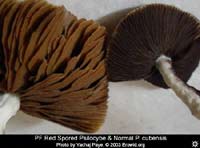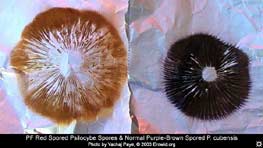Genesis of the PF Redspore Psilocybe
Nov 2003
According to the determination tables of the twentieth century (i.e. before the development of genetic fingerprinting) one of the key features to distinguish the mushroom genus Agrocybe from Psilocybe was the color of the spores. Psilocybe mushrooms have dark violet, almost black spores while Agrocybe spores are of a rusty brown ('fawn') color.
These pictures show the weakness in the classification of mushrooms along the lines of macroscopic features. Shown are the gills and the spores of the 'Psylocybe Fanaticus' redspore cubensis, compared to the spores and gills of a 'PF Classic' Psilocybe cubensis. The redspore is a mutation of the PF Classic mushroom which appeared in Psylocybe Fanaticus' lab (I believe it was somewhere in 1996). Robert 'Billy' McPherson (aka 'Psylocybe Fanaticus'), planned to release the new cubensis variety in the spring of 2003 along with the long awaited 2003 edition of the PF TEK book. Unfortunately the US Government decided to terminate the company www.fanaticus.com on February 18th 2003. During the raid, most of PF's unique collection of cubensis genotypes was seized and later destroyed.
This is the second time the DEA has almost destroyed the life work of a magic mushroom pioneer. The first time was in 1981 when the DEA raided the greenhouse of Stephen Pollock (discoverer of Psilocybe tampanensis and collector of a series of famous cubensis varieties such as the Matías Romero). In the Pollock raid, many unique mushroom strains were lost forever. But a copy of the Fanaticus collection was saved in time and sent in exile to Europe. The unique redspore was among the saved genotypes.
The redspored variety will not immediately be released to the public. The reason is that I first want to find out how to proceed to 'officially' secure Robert McPherson's name to attach to this unique mushroom variety. If it is classified as an Agrocybe then the name should be Agrocybe mcphersonii. It would be the first published example of a psilocybian Agrocybe. The other possibility is that it is the first published example of Psilocybe cubensis with fawn-colored spores. In that case it probably is a 'Psilocybe cubensis var. mcphersonii'. Or even Psilocybe cubensis var. fanaticus. Whatever the outcome of this classification and naming debate will be, this mushroom shows that the mycological determination tables of before the time of gene technology are flawed (unless we assume that an organism can change genus over a single generation).
Psilocybin was confirmed to be present in the variety and it appeared to have the same potency as Psilocybe cubensis.
The spore color is also a neat clearly visible feature which can bring the 'fanaticus' varieties of cubensis mushrooms out of the closet and to the classrooms (to do mushroom breeding experiments). It can serve a similar purpose for mushroom science as the eye color does in Drosophila flies and the color of the peas in plant breeding experiments. This is especially so because the cubensis is perhaps the easiest and fastest microscale cultivatable gilled mushroom known.
No matter what the official Latin name will be, I feel that the name Robert McPherson should be atttached to it, to commemorate the man who popularized the cultivation of psilocybin mushrooms. Twelve years after the publication of the Psylocybe Fanaticus Technique (September 1991) nearly all of the home-cultivated Psilocybe cubensis and a huge portion of the commercially available Psilocybe mushrooms are grown on a PF-style substrate. Evidence of that forms the vermiculite dust on the stems of the mushrooms (vermiculite is an essential ingredient of PF Substrate, a 'batter' of brown rice powder and water on which the mushrooms are grown). This substrate doesn't need a pressure canner and it was invented by Robert McPherson.
Unfortunately, it happens quite often that someone discovers a mushroom, sends it for identification to a mushroom expert and later finds out that the expert has named the mushroom after himself, or a friend or a family member of his. That should not happen here. For that reason the Psilocybe cubensis var. Mcphersonii aka. 'PF Redspore' will not be released until its name is secured.
Yachaj Paye
These pictures show the weakness in the classification of mushrooms along the lines of macroscopic features. Shown are the gills and the spores of the 'Psylocybe Fanaticus' redspore cubensis, compared to the spores and gills of a 'PF Classic' Psilocybe cubensis. The redspore is a mutation of the PF Classic mushroom which appeared in Psylocybe Fanaticus' lab (I believe it was somewhere in 1996). Robert 'Billy' McPherson (aka 'Psylocybe Fanaticus'), planned to release the new cubensis variety in the spring of 2003 along with the long awaited 2003 edition of the PF TEK book. Unfortunately the US Government decided to terminate the company www.fanaticus.com on February 18th 2003. During the raid, most of PF's unique collection of cubensis genotypes was seized and later destroyed.
This is the second time the DEA has almost destroyed the life work of a magic mushroom pioneer. The first time was in 1981 when the DEA raided the greenhouse of Stephen Pollock (discoverer of Psilocybe tampanensis and collector of a series of famous cubensis varieties such as the Matías Romero). In the Pollock raid, many unique mushroom strains were lost forever. But a copy of the Fanaticus collection was saved in time and sent in exile to Europe. The unique redspore was among the saved genotypes.
 |
 |
The redspored variety will not immediately be released to the public. The reason is that I first want to find out how to proceed to 'officially' secure Robert McPherson's name to attach to this unique mushroom variety. If it is classified as an Agrocybe then the name should be Agrocybe mcphersonii. It would be the first published example of a psilocybian Agrocybe. The other possibility is that it is the first published example of Psilocybe cubensis with fawn-colored spores. In that case it probably is a 'Psilocybe cubensis var. mcphersonii'. Or even Psilocybe cubensis var. fanaticus. Whatever the outcome of this classification and naming debate will be, this mushroom shows that the mycological determination tables of before the time of gene technology are flawed (unless we assume that an organism can change genus over a single generation).
Psilocybin was confirmed to be present in the variety and it appeared to have the same potency as Psilocybe cubensis.
The spore color is also a neat clearly visible feature which can bring the 'fanaticus' varieties of cubensis mushrooms out of the closet and to the classrooms (to do mushroom breeding experiments). It can serve a similar purpose for mushroom science as the eye color does in Drosophila flies and the color of the peas in plant breeding experiments. This is especially so because the cubensis is perhaps the easiest and fastest microscale cultivatable gilled mushroom known.
No matter what the official Latin name will be, I feel that the name Robert McPherson should be atttached to it, to commemorate the man who popularized the cultivation of psilocybin mushrooms. Twelve years after the publication of the Psylocybe Fanaticus Technique (September 1991) nearly all of the home-cultivated Psilocybe cubensis and a huge portion of the commercially available Psilocybe mushrooms are grown on a PF-style substrate. Evidence of that forms the vermiculite dust on the stems of the mushrooms (vermiculite is an essential ingredient of PF Substrate, a 'batter' of brown rice powder and water on which the mushrooms are grown). This substrate doesn't need a pressure canner and it was invented by Robert McPherson.
Unfortunately, it happens quite often that someone discovers a mushroom, sends it for identification to a mushroom expert and later finds out that the expert has named the mushroom after himself, or a friend or a family member of his. That should not happen here. For that reason the Psilocybe cubensis var. Mcphersonii aka. 'PF Redspore' will not be released until its name is secured.
Yachaj Paye

